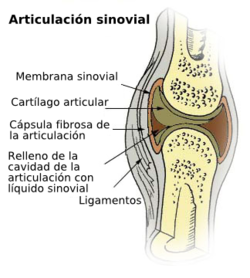Synovitis

Editor-In-Chief: Prab R Tumpati, MD
Obesity, Sleep & Internal medicine
Founder, WikiMD Wellnesspedia &
W8MD medical weight loss NYC and sleep center NYC
| Synovitis | |
|---|---|

| |
| Synonyms | N/A |
| Pronounce | N/A |
| Specialty | N/A |
| Symptoms | Joint pain, swelling, stiffness |
| Complications | Joint damage, arthritis |
| Onset | Can be acute or chronic |
| Duration | Varies depending on cause |
| Types | N/A |
| Causes | Injury, infection, autoimmune disease |
| Risks | Rheumatoid arthritis, gout, lupus |
| Diagnosis | Physical examination, imaging studies, synovial fluid analysis |
| Differential diagnosis | Arthritis, bursitis, tendinitis |
| Prevention | N/A |
| Treatment | Rest, NSAIDs, corticosteroid injections, physical therapy |
| Medication | Nonsteroidal anti-inflammatory drugs, corticosteroids |
| Prognosis | N/A |
| Frequency | Common in rheumatic diseases |
| Deaths | N/A |
Synovitis[edit]
Introduction[edit]
Synovitis is a medical condition characterized by the inflammation of the synovial membrane, a layer of connective tissue that lines the joints, such as the hip, knee, ankle, or shoulder. This inflammation leads to swelling, pain, and warmth in the affected joint. Synovitis is often associated with various types of arthritis and other diseases.
Anatomy and Physiology[edit]
Synovial Membrane[edit]
The synovial membrane is a specialized connective tissue that lines the inner surface of capsules of synovial joints and tendon sheath. It plays a crucial role in producing synovial fluid, which lubricates and nourishes the joint.
Causes and Risk Factors[edit]
Synovitis can be caused by a variety of factors, including:
- Rheumatoid arthritis
- Osteoarthritis
- Gout
- Trauma or injury to the joint
- Infections involving the joint
Symptoms[edit]
The primary symptoms of synovitis include:
- Joint swelling
- Pain and tenderness in the affected joint
- Warmth and redness around the joint
- Stiffness, especially in the morning or after periods of inactivity
Diagnosis[edit]
Clinical Examination[edit]
A thorough clinical examination by a healthcare provider is essential. This may include:
- Assessment of the symptoms
- Physical examination of the affected joint
Imaging and Laboratory Tests[edit]
- X-rays: To assess joint damage
- MRI or Ultrasound: For a detailed view of the synovial membrane
- Blood tests: To identify markers of inflammation or infection
Treatment[edit]
Treatment of synovitis aims at reducing inflammation and managing the underlying cause. It may include:
- Nonsteroidal anti-inflammatory drugs (NSAIDs)
- Corticosteroid injections
- Physical therapy
- In severe cases, surgical intervention may be necessary
Prevention and Management[edit]
While some causes of synovitis cannot be prevented, certain measures can help manage the condition and reduce the risk of flare-ups:
- Regular exercise to maintain joint flexibility
- Weight management to reduce stress on joints
- Avoiding activities that put excessive strain on the joints
Prognosis[edit]
The prognosis for synovitis largely depends on the underlying cause. Early diagnosis and treatment can significantly improve outcomes.
Related Conditions[edit]
References[edit]
<references>
- Arthritis Foundation - About Synovitis
- National Center for Biotechnology Information - Synovitis and Synovial Fluid
</references>
External Links[edit]
Ad. Transform your life with W8MD's Budget GLP-1 injections from $75


W8MD offers a medical weight loss program to lose weight in Philadelphia. Our physician-supervised medical weight loss provides:
- Weight loss injections in NYC (generic and brand names):
- Zepbound / Mounjaro, Wegovy / Ozempic, Saxenda
- Most insurances accepted or discounted self-pay rates. We will obtain insurance prior authorizations if needed.
- Generic GLP1 weight loss injections from $75 for the starting dose.
- Also offer prescription weight loss medications including Phentermine, Qsymia, Diethylpropion, Contrave etc.
NYC weight loss doctor appointmentsNYC weight loss doctor appointments
Start your NYC weight loss journey today at our NYC medical weight loss and Philadelphia medical weight loss clinics.
- Call 718-946-5500 to lose weight in NYC or for medical weight loss in Philadelphia 215-676-2334.
- Tags:NYC medical weight loss, Philadelphia lose weight Zepbound NYC, Budget GLP1 weight loss injections, Wegovy Philadelphia, Wegovy NYC, Philadelphia medical weight loss, Brookly weight loss and Wegovy NYC
|
WikiMD's Wellness Encyclopedia |
| Let Food Be Thy Medicine Medicine Thy Food - Hippocrates |
Medical Disclaimer: WikiMD is not a substitute for professional medical advice. The information on WikiMD is provided as an information resource only, may be incorrect, outdated or misleading, and is not to be used or relied on for any diagnostic or treatment purposes. Please consult your health care provider before making any healthcare decisions or for guidance about a specific medical condition. WikiMD expressly disclaims responsibility, and shall have no liability, for any damages, loss, injury, or liability whatsoever suffered as a result of your reliance on the information contained in this site. By visiting this site you agree to the foregoing terms and conditions, which may from time to time be changed or supplemented by WikiMD. If you do not agree to the foregoing terms and conditions, you should not enter or use this site. See full disclaimer.
Credits:Most images are courtesy of Wikimedia commons, and templates, categories Wikipedia, licensed under CC BY SA or similar.
Translate this page: - East Asian
中文,
日本,
한국어,
South Asian
हिन्दी,
தமிழ்,
తెలుగు,
Urdu,
ಕನ್ನಡ,
Southeast Asian
Indonesian,
Vietnamese,
Thai,
မြန်မာဘာသာ,
বাংলা
European
español,
Deutsch,
français,
Greek,
português do Brasil,
polski,
română,
русский,
Nederlands,
norsk,
svenska,
suomi,
Italian
Middle Eastern & African
عربى,
Turkish,
Persian,
Hebrew,
Afrikaans,
isiZulu,
Kiswahili,
Other
Bulgarian,
Hungarian,
Czech,
Swedish,
മലയാളം,
मराठी,
ਪੰਜਾਬੀ,
ગુજરાતી,
Portuguese,
Ukrainian


